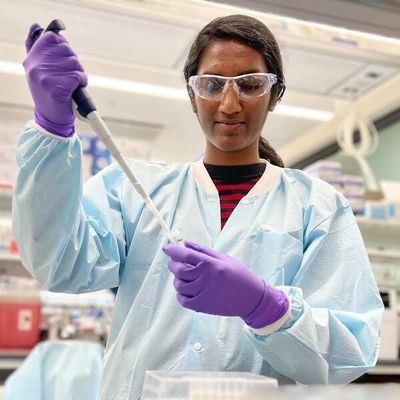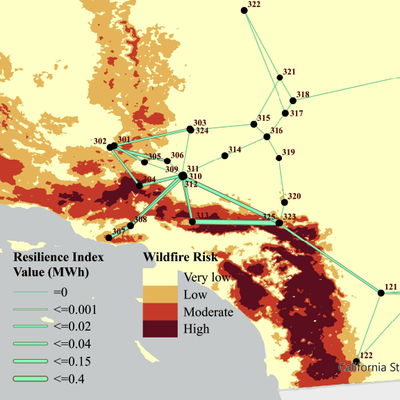- Undergraduate
Bachelor's Degrees
Bachelor of ArtsBachelor of EngineeringDual-Degree ProgramUndergraduate AdmissionsUndergraduate Experience
- Graduate
Graduate Experience
- Research
- Entrepreneurship
- Community
- About
-
Search
Research Quick Takes

Oct 09, 2025
Strategic Cyber Defense
PhD student Mai Pham and professors Vikrant Vaze and Peter Chin coauthored "Strategic Cyber Defense via Reinforcement Learning-Guided Combinatorial Auctions" which was chosen for presentation at the IEEE High Performance Extreme Computing Conference. "This work formulates the cyber defense problem, in which we act as a defense agent protecting a network from malware attackers, as a combinatorial auction," said Pham. "We combined reinforcement learning with differentiable mechanism design to find the best resource allocation for the hosts, which aims to upstream decision making and proactively protect the network."

Oct 09, 2025
Toward Greener Batteries
Research Associate Peiyu Wang Th'25, PhD students Huilin Qing and Ruiwen Zhang, and Professor Fiona Li coauthored "Fluorine-free electrolytes for sustainable lithium batteries: a review" published in npj Materials Sustainability. The paper highlights insights and advances in fluorine-free salts, solvents, additives, and interphases, along with challenges and opportunities, offering sustainable solutions potentially competitive with conventional fluorinated electrolytes. "Modern lithium battery electrolytes rely on fluorinated components to enhance performance and functionality, but such schemes raise safety, environmental, and cost concerns due to hydrogen fluoride generation and hazardous production," said Li.

Oct 02, 2025
Biology of Human Milk
Goods Lab PhD student Laasya Devi Annepureddy is co-lead author of "Integrated ‘omics analysis reveals human milk oligosaccharide biosynthesis programs in human lactocytes" published in iScience. The study reveals pathways for how breastmilk cells produce sugars that are critical to infant health and development, and paves the way for being able to add them to formula or as a supplement to certain foods. "Being part of this project has been incredibly rewarding," said Annepureddy. "Our findings bring us one step closer to understanding the remarkable biology of human milk, and I’m grateful to the outstanding team whose collaboration made this work possible."

Oct 02, 2025
Atomic Neighborhoods in Semiconductors
Professor Jifeng Liu is coauthor of "Identification of short-range ordering [SRO] motifs in semiconductors" published in Science. Using electron microscopy and machine learning models, the study confirmed the presence of semiconductor SRO—where atoms form mini configurations or "neighborhoods" within the material. The concept of SRO has lacked experimental evidence, and this confirmation opens up new possibilities for controlling the properties of semiconductors. "My lab was the first to identify the samples that revealed signs of atomic ordering, and I initiated and promoted the idea that engineering atomic neighborhoods in semiconductors offers a new degree of freedom for controlling their electrical and optical properties," said Liu.

Sep 25, 2025
Applications of Liquid Metal Materials
Saifur Rahman Th'25 and Professor Will Scheideler coauthored "Liquid Metals in Radio Frequency Applications: A Review of Physics, Manufacturing, and Emerging Technologies" published in Advanced Electronic Materials. "Liquid metal materials are transforming soft and stretchable radio frequency devices by enabling highly-conductive, mechanically-adaptable components that can conform to wearable and bio-integrated applications," said Scheideler. "This work highlights the physics of energy loss in liquid metal systems, innovative fabrication techniques, and diverse applications."

Sep 18, 2025
Protecting the Grid from Wildfire
PhD student Soroush Vahedi and Professor Junbo Zhao are lead authors of "Probabilistic Resilience-Oriented Assessment Approach for Transmission Networks under Wildfires" published in IEEE Transactions on Power Systems. Their approach provides critical insights for identifying system vulnerabilities and developing robust strategies to protect transmission networks from wildfires.

Sep 11, 2025
Safe Reinforcement Learning
PhD student Tong Su and Professor Junbo Zhao are coauthors of "A Review of Safe Reinforcement Learning Methods for Modern Power Systems," published in and featured on the cover of Proceedings of the IEEE. The article "summarizes existing safe RL techniques, evaluates their performance, analyzes suitable deployment scenarios, and examines algorithm benchmarks and application environments."

Sep 11, 2025
Broadband Microwave Sensor
Professor Paul Meaney and Research Associate Zamzam Kordiboroujeni are coauthors of "Real-Time Microwave Medical Scanning" published in IEEE Microwaves Magazine. "We have developed a new broadband microwave sensor for detecting and diagnosing subsurface medical conditions such as sarcopenia," states the article. "The device is an open-ended coaxial concept that has been fabricated using 3D metal printing technologies."

Sep 04, 2025
New Energy Editor
Professor Junbo Zhao was appointed editor-in-chief of the International Journal of Electrical Power & Energy Systems. "This is a prestigious journal with a long history in the power and energy field, and I am very honored to be appointed. This is great opportunity to make contributions to our community and increase Thayer's visibility to the world in the energy domain," said Zhao.

Sep 04, 2025
Climate Change Collaborator
Professor Erin Mayfield was selected to serve as a lead author of the Intergovernmental Panel on Climate Change (IPCC) Seventh Assessment Report. IPCC is the UN body for assessing the science related to climate change, and Mayfield is one of 664 experts from 111 countries appointed to participate. Assessment reports are published every 5 to 7 years to provide governments with information to develop climate policies, and to inform international negotiations to tackle climate change.

Sep 04, 2025
NIH Research Award
Professor Wei Ouyang was awarded a Maximizing Investigators’ Research Award (MIRA) from the National Institute of General Medical Sciences (NIGMS), part of the National Institutes of Health. The award provides $2.2 million over five years to support Ouyang's research on implantable technologies for monitoring internal organ health. His work aims to advance understanding of the pathophysiology underlying post-operative complications and inform the development of safer, more effective interventions.

Aug 21, 2025
3-Minute Research Pitch
PhD student Aleyna La Croix received an honorable mention at this year's Orthopaedic Research Society (ORS) International Section Fracture Repair (ISFR) 3-Minute Research Pitch Competition. Her pitch was titled, "Shocking Revelations in Cryogelation: Sparking musculoskeletal regeneration." Watch video
